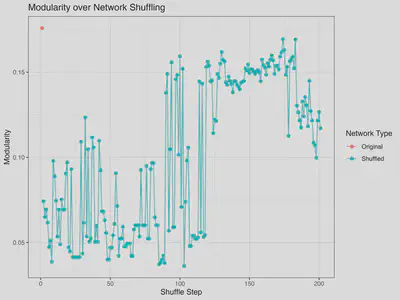Using Infomap for Food Web Modularity
This post introduces how to calculate and assess modularity in food web networks using the multiweb R package. We illustrate this with the Potter Cove food web (included in the package as netData[[23]]) and show how to run Infomap, compare implementations, and apply network randomization routines.
You need to install infomap
and ‘multiweb’
require(devtools)
install_github("lsaravia/multiweb")
Run Infomap on an Empirical Food Web
We use the run_infomap() function, an interface between R and the external Infomap binary:
library(multiweb)
library(tidyverse)
g <- netData[[23]] # Potter Cove food web
py_infomap0 <- run_infomap(g, output_dir = ".", return_df = TRUE)
py_infomap0$codelength
[1] 4.36376
To explore the module membership:
py_infomap0 <- py_infomap0$communities
py_infomap0 %>% filter(module == 1)
Output for module 1:
module node flow
1 1 Gobionotothen gibberifrons 0.0162264
2 1 Notothenia rossii 0.0593102
3 1 Harpagifer antarcticus 0.0411967
4 1 Lindbergichthys nudifrons 0.0255800
5 1 Chaenocephalus aceratus 0.1391530
6 1 Parachaenichthys charcoti 0.0024676
Alternatively, retrieve an igraph-compatible object:
py_infomap <- run_infomap(g)
py_infomap$codelength
IGRAPH clustering infomap, groups: 7, mod: 0.18
+ groups:
$`1`
[1] "Gobionotothen gibberifrons" "Notothenia rossii" "Harpagifer antarcticus" "Lindbergichthys nudifrons"
[5] "Chaenocephalus aceratus" "Parachaenichthys charcoti"
$codelength
[1] 4.36376
❗ A Note on cluster_infomap
The same algorithm is included in igraph as cluster_infomap(), but it produces different results:
ig_infomap <- cluster_infomap(g)
ig_infomap$codelength
IGRAPH clustering infomap, groups: 1, mod: 0
+ groups:
$`1`
[1] "Aged detritus" "Polychaeta" "Polynoidae" "Gitanopsis squamosa"
[5] "Gobionotothen gibberifrons" "Notothenia rossii" "Ophionotus victoriae" "Aequiyoldia eightsii"
[9] "Salpidae" "Gammaridea" "Ostracoda" "Oligochaeta"
+ ... omitted several groups/vertices
[1] 5.845473
We validated our results against the Infomap web interface and found that run_infomap() yields consistent and accurate results. We therefore recommend not using cluster_infomap() for empirical studies.
Randomizing Networks for Null Model Comparison
1. Curveball Randomization
We can randomize networks using the curveball algorithm, which preserves row/column sums (degree sequence):
gl <- curve_ball(g)
modl <- calc_modularity(gl, cluster_function = run_infomap)
Plotting the distribution of modularity across replicates:
ggplot(modl, aes(x = Modularity)) +
geom_density(fill = "skyblue", alpha = 0.5) +
geom_vline(xintercept = py_infomap$modularity, color = "red", linetype = "dashed") +
labs(title = "Distribution of Modularity under Curveball Randomization",
x = "Modularity", y = "Density") + theme_bw()

2. Degree-Preserving Shuffling
This routine preserves the in- and out-degree sequence via iterative edge swaps:
shuffle_network_deg(input_graph, delta = 10)
Where delta is the number of swaps
We use this in a more systematic way with:
results <– generate_shuffled_seq(
netData[[29]],
max_delta= 200,
modularity_func = run_infomap,
shuffle_func = shuffle_network_deg
)
This produces a sequence of 200 networks each with 10 edge swaps using the shuffle_network_deg algorithm
Plotting modularity over shuffle steps can help detect when modularity deviates from the empirical structure.
# Extract modularity metrics
metrics_df <- result$Metrics
# Add a column identifying the original vs shuffled
metrics_df$Type <- ifelse(metrics_df$Step == 1, "Original", "Shuffled")
# Plot modularity over shuffle steps
ggplot(metrics_df, aes(x = Step, y = Modularity, color = Type)) +
geom_line() +
geom_point(size = 2) +
labs(title = "Modularity over Network Shuffling",
x = "Shuffle Step",
y = "Modularity",
color = "Network Type") +
theme_bw()

The graph shows that gradual shuffling runs through the distribution of modularity values obtained by the curve_ball routine (previous graph) and at least in 200 iterations no stabilization of modularity is observed.
Summary
run_infomap()wraps the external Infomap binary and gives reliable modularity estimates.cluster_infomap()(igraph) gives different results than the original app.- Randomization routines like
curve_ball()andshuffle_network_deg()help assess structural significance. shuffle_network_deg()is useful for increasingly randomize the network in steps but it is slower for a complete randomization.curve_ball()randomize the network in an efficient and unbiased way- Visualizing modularity distributions is key for interpreting modular structure.
Resources
- 📦 multiweb GitHub Repository
- 📘 Infomap Installation
- 📄 Strona et al. 2014. Nature Communications 5:4114. https://doi.org/10.1038/ncomms5114
Feel free to reach out or open an issue on GitHub if you’d like to contribute!